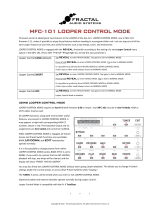
10
Wireless Setup
POD Go Wireless has a built-in Relay® wireless receiver and includes a Relay G10TII
wireless transmitter, so you can play untethered. Please be sure to check that your Relay
transmitterisupdatedwiththelatestrmware—seepage 4.
1. Anytime you bring POD Go Wireless into a new room or building,
always connect the G10TII transmitter to POD Go’s GUITAR IN jack.
POD Go Wireless scans the environment to choose the optimal wireless channel
and frequency.
2. Wait 10 to 15 seconds.
Think about how cool it’s gonna be to never trip over your guitar cable and land
facerstintoyourdog’sfoodbowl.Again.
3. Remove the transmitter from POD Go Wireless and connect it to
your guitar’s output.
The G10TII’s battery lasts for 7 hours of playing time or about a month when
inserted into the rear panel storage well.
4. Select the Input block on your POD Go Wireless device, press
the lower knob, and choose either the “Guitar+Wireless” or
“Wireless” as your input source.
For best wireless perfor-
mance, try to maintain line-
of-sight between the wireless
transmitter and the antenna
above the expression pedal.
POD Go wireless has a line-
of-sight range of up to 100
feet (30 meters).
Facing away from POD Go
Wireless can sometimes
aect wireless performance,
as your body can interfere
with wireless signals.
Also avoid covering the an-
tenna with cables, other
pedals, or small woodland
creatures.
Maintain a safe distance (at
least 10 feet/3 meters, but
preferably more) from 2.4GHz
WiFi routers. If a WiFi router
must be in your performance
environment, switch it to
operate at 5GHz, if possible.
Transmitter Battery and Signal Indicators
At the top left of the LCD screen, POD Go Wireless always displays two icons:
the Battery Life indicator and either the RF Quality indicator, or the Charging or
Syncing icon, as pictured and described below.
ThersttimePODGoWirelessispoweredon,thebatteryoutlineisemptyand
the RF bars display as dimmed, indicating no transmitter can be found (see No
Tx Found below).
1. Connect G10TII to POD Go Wireless’ GUITAR IN jack.
Syncing Charging Fully Charged
While the transmitter is syncing, a sync icon is displayed (see Syncing above).
Once syncing is complete, while the transmitter is connected to the GUITAR IN
jack, a blue charging icon is displayed (see Charging above).
When fully charged, the battery icon is displayed with all three bars bright green
(see Fully Charged above).
NOTE: Any time you move POD Go Wireless into a new environment, connect
the G10TII to its GUITAR IN jack to perform a sync. Sync scans the frequency
spectrum and automatically chooses the optimal wireless channel. You may also
manually select the wireless channel from the Global Settings > Wireless menu.
2. Once sufficiently charged, remove the transmitter from the
GUITAR IN jack and connect to your guitar’s output.
POD Go Wireless continues to show the transmitter battery life indicator as well
as a 3-bar RF signal strength indicator to its right. When no active transmitter
is detected, an “empty” battery and dim RF bars are shown (see No Tx Found
below). The remaining battery time and RF signal strength values are indicated as
described below.
No Tx Found
No Tx FoundRF LowRF MediumRF High
< 30 mins.
30 mins-
1.5 hours
1.5 hours-
3 hours
3 hours-
4.5 hours> 4.5 hours
IMPORTANT!IfyouturnoPODGoWirelesswhiletheG10TII is in the Guitar/
Charge port, it will remain in sleep mode and slowly lose charge over a week or
so. Not a problem if you play POD Go Wireless every day, but a huge bummer
when you come back from vacation (which is why you should bring POD Go
Wirelessonvacationwithyou!).Whileinthestoragewell,theG10TII may retain
its charge for a month or more, so it’s ready to go when you are.




















